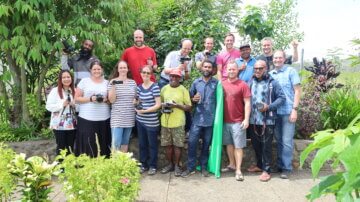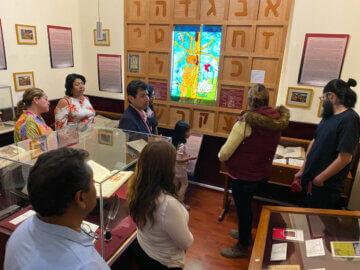Leadership Foundations: The Changing Nature of Leadership
Synopsis:
Articles 14-17 outline leadership principles, including cultural influences that affect how organizations like Wycliffe Global Alliance are led. These articles explore fundamentals from theories of leadership and management that prove helpful in formulating a leadership foundation that undergirds an organization like the Alliance.
Other international mission agencies are surveyed, to find out what influences their organizational structure. Recent events that have shaped leadership and organizational development within the Alliance are observed. The conclusions guide leaders toward development of a global leadership model for the future.
Defining the term ‘leadership’ in order to determine how to have effective leaders in a local, national and global context is a starting point, but not straightforward, since there are many definitions, perspectives and assumptions on the topic.
Questions to consider include: whether the business world offers help to leaders in God’s mission; whether leadership is the same as management; whether leaders are made or born; and whether there is a common set of traits in determining success in leaders.
The use of power is a fundamental assumption of the effectiveness of leaders. However, the notion of power is somewhat intangible and deserves closer scrutiny. Power can be seen as a method of control or a means of influence. Traditionally, power has been seen as essential to management and getting people to do something they didn’t want to do. Leadership, however, can benefit from exploring the potential of influence which can play to peoples’ strengths and abilities.
Full Article: Article 14 – Leadership Foundations: The Changing Nature of Leadership
Introduction
In this and the following two articles I outline leadership principles, including cultural influences that affect how organizations like Wycliffe Global Alliance are led. I explore fundamentals from theories of leadership and management that prove helpful in formulating a leadership foundation that undergirds an organization like the Alliance. I survey other international mission agencies to find out what influences their organizational structure. And I look at recent events that have shaped leadership and organizational development within the Alliance. From this input, I make conclusions to guide Alliance leaders toward development of a global leadership model for the future.
The role of leaders
Many leadership development programs assume that leadership is “the single most critical factor in the success or failure of institutions” (Vecchio 1997:12). There is also a broader impact and that is in the context of nations. Micah Amukobole states that in his country of Kenya, “misuse of power, impunity, and corruption by the ruling class at the expense of the population are the order of the day” (2012:3).
In determining how to have effective leaders in a local, national and global context, a starting point is to define the term ‘leadership’. However, this is not straightforward since there is a plethora of definitions, perspectives and assumptions on the topic.
The diversity of opinion enables one to look at the term quite broadly. For example, Bernard Bass notes how in the Old Testament, God, as supreme leader of the Israelites, “clarified, instructed, and directed what was to be done through the words of the Prophets and arranged for rewards for compliance and punishment for disobedience to the laws and rules he handed down to Moses” (Vecchio 1997:8).
Some definitions of leadership are quite grand in their perspective. Roger Parrott sees the role of the leader as “stretching boundaries and securing territory [as they] envision, probe, and then explore new opportunities” (2009:171).
Other definitions focus on issues like influence and social impact. Amukobole, for example, views an effective leader as one who uses their “ability to influence others without resorting to threats” (2012:7). Robert Kelly sees leadership as “the process of influencing an organized group toward accomplishing its goals” (Wren 1995:43). On the other hand, J. Oswald Sanders (1967:19) claims a leader is the one who influences someone else. A similar view is that a leader is someone who can exert social influence on others and thereby accomplish a common goal (van Vugt & Ahuja 2010:14).
The mark of a great leader is found in their followers.
Leaders must involve their followers and this is done best by gaining their trust through persuasion or by the good example of the leader (Dickson 2011:40). Max De Pree says the mark of a great leader is found in their followers: “Are they reaching their potential? Are they learning? Serving? Do they achieve the required results? Do they change with grace? Manage conflict?” (1989:10). Leaders who communicate to followers their worth and potential will subsequently enable their followers to achieve their full potential (Covey 2004:98).
Another perspective views leadership as “inspiring others to contribute their best efforts toward a goal” (Dickson 2011:24) or stated differently, it “involves influencing other people to accomplish certain tasks or goals” (REC 2005:24). John Dickson sees leadership as more of an art than a science because it “tends to be flexible, depending on the goals of the organization, and intuitive, depending on the personalities involved” (2011:24).
Some researchers distinguish between ‘natural leadership’ and ‘spiritual leadership’. While the two share much in common, the latter exhibits unique characteristics because the spiritual leader’s influence is not by the power of their personality alone, but by that personality as it empowered by the Holy Spirit (Sanders 1967:20). Furthermore, spiritual leadership or “faith-based leadership is more about who we are [in Christ] than what we do” (Robinson 2008:4).
How leaders lead in the context of the missio Dei ... is demonstrated as they focus, harmonize and develop the gifts of others for the glory of God and his kingdom.
Some who explore how leaders lead in the context of the missio Dei suggest that such leaders must be “fervent disciples of Jesus Christ, gifted by the Holy Spirit, with a passion to bring glory to God” (Plueddemann 2009:15). Their gift of leadership is demonstrated as they focus, harmonize and develop the gifts of others for the glory of God and his kingdom.
A question to consider is whether the business world offers help to leaders in God’s mission. Eddie Gibbs notes a shift is taking place in leadership in the business world towards “humility, a servant attitude, spirituality and consistently upheld values” (2005:22). These, he says, are consistent with biblical themes on the subject and therefore leaders in the church and mission agency context should thoughtfully consider leadership definitions from the business world since these are “symbiotic... rather than a class of opposites” with their Christian counterparts (2005:22).
Another question is whether leadership is the same as management. Harvard Business School professor John Kotter says “leadership and management are two distinctive and complimentary systems of action [and] both are necessary for the success in an increasingly complex and volatile business environment” (Vecchio 1997:24). Management focuses on bringing order to complexity and involves flexibility and adaptation to the changing environment (Chemers 1997:3).
A further question is whether leaders are made or born.
A further question is whether leaders are made or born. Some think that leadership is learned because it is more about “character, the soft skills, interpersonal relationships and communication, community building, visioning, and empowering others” (REC 2005:50). Researchers note how successful leaders almost always began leading during their twenties and thirties. They learned to take risks and in particular they learned from their successes and failures (Vecchio 1997:32).
Placing new leaders is an important strategy for the health of any organization. Current leaders must therefore identify and develop future leaders (De Pree 1989:12). On-the-job learning is a critical way to develop a broad range of leadership skills. It also helps people realize how difficult it is for leaders to produce change within a given context (Vecchio 1997:32). As an organization develops new leaders it should do so based on the emerging leader’s aptitude to “enhance an organization’s performance” (Vecchio 1997:60). The success of any leader is critical for an organization because when leadership fails at any time and any stage it robs the organization of its vitality (Robinson 2008:4).
One more factor is a leader’s personality and context. Gibbs warns that it is unwise to “simply transpose one style of leadership from one particular time, location and cultural setting and apply it to another” (2005:30). Caution should be followed in assuming a leader, such as in the Bible or in history, uses a leadership style that is immediately applicable to a contemporary situation.
Contemporary challenges for leaders
In order for leaders to be effective they should focus on three dynamics: 1) projecting an image of competence, especially trustworthiness by virtue of their values and behaviour; 2) developing a relationship with their followers such that they enable them to make meaningful contributions to the goals of the organization; and 3) rallying resources of everyone in their organization to fulfil the organization’s needs (Chemers 1997:173).
A vital factor affecting an organization’s survival and adaptability is in its ability to lead and manage change in national, regional and global environments. Change demands that the highest levels of leadership must deal with complex choices about the organization’s strategy (Vecchio 1997:48). Leaders must overcome complacency because people can be fearful of the consequences of change.
Leaders must overcome complacency because people can be fearful of the consequences of change.
Leaders with vision enjoy the challenge of big ideas in order to protect the organization from failing and create a safe place for the best ideas to flourish. A leader with vision must create “a rational case directed toward the mind into an experience that is very much aimed at the heart” (Kotter 2008:47).
A critical skill for a leader to master is problem solving. Determining how a leader responds to challenging circumstances is a good indicator of how the person is doing in this area. Consequently, if a leader habitually reacts negatively to a situation by seeing it as a threat rather than an opportunity, it is a good sign that the person should no longer be in that leadership position (Gibbs 2005:138).
Genuine transformation is gained by taking the longer path and not relying upon short-term solutions.
In Western contexts, leaders are raised in a world that prizes instant results. This affects the church environment, too, because it may believe that immediate results trump lasting change. However, genuine transformation is gained by taking the longer path and not relying upon short-term solutions. Jesus exhibited the ultimate example of “longview [sic] leadership” (Parrott 2009:12) because his focus was set on eternity while he was on earth. He evaded simple solutions and solved problems in ways that would have a long-term impact on his disciples as they developed into leaders.
Leadership traits
Leadership can be influenced by many factors, including but not limited to, the personality of the leader. An effective leader always has “some observable ability that commands respect from the team” (Dickson 2011:29). The leader can shape the behaviour of the group through various forms of persuasion and by exerting power to achieve goals (Vecchio 1997:17).
A question is whether there is a common set of traits in determining success in leaders. The answer is complex. Starting in the 19th century the ‘great man theory’ said that great leaders possess some special trait that propels them to positions of prominence regardless of the circumstances. In other words, there was something inherent in a person who was a leader that “provided the unique qualifications for that person’s ascendancy” (Chemers 1997:19).
A trait common to successful leaders is a stable, personal disposition (Chemers 1997:26). This trait is deployed by: 1) projecting an image that is consistent with what observers’ expect; 2) successfully creating and sustaining motivated and competent followers; and 3) the capacity for using personnel for the success of the mission (Chemers 1997:27).
Some suggest that leadership is “fundamentally about forming character and living a life shaped by virtue” (Roxburgh & Romanuk 2006:118). Others add that humility is essential because it “enhances persuasiveness” (Dickson 2011:41). Other desired traits include charisma, creativity and flexibility (Wren 1995:141).
Not all leadership theorists agree that there are universal traits, noting that some leaders are effective in some situations but not others. Sometimes failure in one situation produces strength in a different situation. The reason being, effective leadership is “dependent on a subtle set of interpersonal relationships rooted in a particular context of task and authority” (Chemers 1997:32).
Leadership typology
There is a diverse range of types of leadership. Internal and external influences cause leaders to act or operate in certain ways. For example, the following chart represents a breakdown of leader types according to Chemers:
 The following chart displays a representation of leader types in a different way, combining the analyses of Chemers, Vecchio, Wren, Amukobole, Laniak, and Roxburgh & Romanuk:
The following chart displays a representation of leader types in a different way, combining the analyses of Chemers, Vecchio, Wren, Amukobole, Laniak, and Roxburgh & Romanuk:
The use of power
The use of power is a fundamental assumption of the effectiveness of leaders. Without some degree of power a leader finds it difficult to manage the group. However, the notion of power is somewhat intangible and needs close scrutiny. A positive way to define it is the “ability to change the behaviour of others; [or] the ability to cause others to perform actions that they might not otherwise perform” (Vecchio 1997:71). Influence is similar to power but it is more subtle and it can be weaker and less reliable than power.
Leadership theorists have defined positive and negative uses of power: 1) ”rewarding power” gives results by rewarding the group when its achieves positive objectives; 2) “coercive power” produces fear in the group with the risk of retribution if objectives are not met; 3) “legitimate power” occurs when the group accepts their leader’s authority and direction; 4) “referent power” is attained when the group follows the leader because of the leader’s charm, charisma and success; and 5) “expert power” happens when the leader uses their expertise, knowledge or talent in a given area and the group responds accordingly (Vecchio 1997:74-5).
The latest
View all articles
03/2024 Pacific: Papua New Guinea
Informing, teaching, inspiring: PNG workshop teaches video storytelling for language communities
PNG workshop teaches video storytelling for language communities
Read more
02/2024 Global
Looking ahead at 2024
As the year unfolds, we marvel at the work of God in our rapidly changing world. And, we look forward to a number of gatherings and conversations intended to draw us together.
Read more
01/2024 Americas
Telling the Bible's Story
It may come as a surprise that a museum is among the Wycliffe Global Alliance organisations.
Read more
